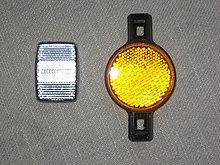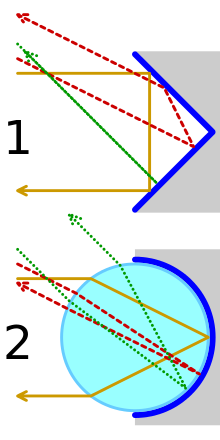Retroreflector
A retroreflector (from the Latin retro backward, reflexio backward diffraction) is a device that largely reflects incident electromagnetic waves in the direction from which they came, largely regardless of the direction of incidence and the orientation of the reflector . This is known as retroreflection .
background
Diffusely scattering surfaces reflect only a small amount of light back to the light source. Nevertheless, they usually appear brighter than a mirror, because the reflection of a plane mirror depends on its orientation, which is perpendicular to the viewer only in exceptional cases. For this reason, a wet roadway that is only illuminated by the vehicle's own headlights appears darker at night than the diffuse backscattering surface of a dry road surface.
application
In radio technology, radar reflectors help locate irradiated objects, such as a balloon probe or a bridge pillar on a waterway .
A triple prism made of cut glass serves as a turning point for a laser when measuring . At a reflective light beam a is retroreflective sheeting , or a retro-reflector used to redirect the beam back to the sensor directly adjacent the light source.
In road traffic, retroreflectors on people, obstacles, traffic signs , guidance systems and vehicles increase their visibility at night in the headlights . The driver's eyes are usually about 1 m away from the headlights of your vehicle. Since an ideal retroreflector would theoretically reflect the light exactly in the direction of incidence, retroreflectors for road traffic have a small angular spread of around 1 °. Retroreflectors have a critical angle of retroreflection compared to their surface normals, from which they no longer reflect. The parameters angular dispersion and critical angle of retroreflectors are used to characterize them.
In white or colored versions, there are reflex reflectors made of transparent plastic injection-molded or glass plates that are smooth at the front and have a structure made up of many cube corners at the rear. Sometimes they are also mirrored at the back, but non-mirroring also results in retroreflection. These elements are also often referred to as cat eyes.
Retroreflector foils are made of embossed aluminum foil, plastic foil embossed on the back or contain transparent, retroreflective beads.
Cat eyes are made of glass bodies (biconvex, silver mirrored and coated with protective coating).
If retroreflectors are fogged up by drops of dew or hoar frost, this can reduce or completely prevent the retroreflection due to scattering ; Motorway signposts show large dark spots in such cases.
Some bicycle headlights have integrated retroreflective zones.
In security applications, retroreflective materials should be combined with diffusely reflective surfaces so that they are also recognizable when they are irradiated with extraneous light from other directions. For this reason, delineators not only have reflectors, but are also colored white. Even aluminum , often extruded and anodized, used as traffic signposts or railings looks bright as long as it is not severely corroded by salt .
In the case of road markings , glass balls ( d <0.3 mm) are partially embedded in the applied marking paint (paint or liquid plastic) by sprinkling it on, which results in retroreflection. The effect of the glass beads is similar to that of the Lüneburg lens .
In nature, retroreflection occurs on dewy plants when they are very hairy. Grass and grain stalks also show the effect. This "halo" becomes visible around the shadow of your own head in the green when the sun shines at medium height from behind. The phenomenon also occurs on hairless plants if their leaves are so strongly hydrophobic due to a layer of wax that the contact angle on the dewdrop increases to 140 °, which Alistair B. Fraser observed on conifers and was therefore called sylvanshine (English forest glow). Conversely, designers of military vehicles, ships and especially aircraft try to avoid unwanted radar reflections by strictly avoiding inner corners on their outer contour ( stealth technology ).
Retroreflectors made of quartz glass (to also reflect UV light components) are used for long-path measurements based on the DOAS technology to detect atmospheric trace gases in the air on a defined light path.
Other effects
- glory (english)
- gloriole
- Opposition effect : the full moon appears much brighter than the crescent moon, a dusty road appears brightest around the opposite point of the light source behind you, and (dry) meadows, fields and forests appear significantly lighter around your own (sun) shadow. Because rough structures cast shadows on themselves. From the point of view of the direction of illumination, however, these shadows are covered by the illuminated surfaces.
Retroreflective elements
In addition to plan-optic corner reflectors (triple mirrors and triple prisms) and retro reflectors, there are rotationally symmetrical lens reflectors ( cat's eyes , Lüneburg lenses ) and, in principle, other types of retroreflective bodies, for example biconic constructions.
Versions with three reflective surfaces
Three flat, mutually perpendicular, reflective surfaces guide incoming waves back to the source of the waves. The three faces are arranged like the three faces of a cube that touch a corner. This is why this corner reflector is also called a corner cube in English .
Examples of corner reflectors:
- Triple mirrors and triple prisms made of glass for retroreflection of laser beams ( LIDAR ) when surveying , measuring the distance to the moon and for determining the exact position of satellites
- A triple prism is a glass body that is flat at the front and has three non-mirrored flat surfaces at an angle of 90 ° to each other on the back. In principle, it even reflects with less loss than a triple mirror, even if the front surface is not anti-reflective. The cause is the loss-free total reflection on the sloping rear surfaces. Triple prisms have a larger angular range within which the reflection occurs, since the front surface of the glass body causes a refraction towards the axis of symmetry.
- Radar reflectors made of sheet metal as retroreflectors for microwave radiation ( RADAR ), e.g. for shipping in front of bridge piers.
- Reflectors made of plastic, and more rarely also made of glass, have triple prisms molded on the back, which function like triple mirrors with a sufficient refractive index through total reflection. They are usually covered at the back to avoid interference from dirt and (condensation) water.
Effect of triple reflectors on polarization
Triple reflectors rotate the polarization of the incident light waves by about 90 °. This effect is used in optoelectronics to detect reflective objects with retro- reflective light barriers . There is a polarization filter in front of the transmitter and in front of the receiver, rotated by 90 ° to each other. If linearly polarized light has been directed from the triple reflector to the receiver through the first filter, it can pass through the second polarization filter because of the rotation of the polarization. Light directed to the receiver through a single reflective surface is blocked by the second polarizing filter. In this way, despite the reflection, it is reliably recognized that an object is in the area of the light barrier.
Lens-like design

If there is a reflective surface in the focus of an imaging optic, the reflected light is directed back towards the light source by the optic. Unlike a simple flat mirror, this property does not depend on the exact orientation of the reflecting surface. For an ideal retroreflection, however, the distance between the reflective surface must be exactly right. In addition, lens defects mean that the light is not completely directed towards the light source. In some applications, a reflection in an area close to, but not exactly at the light source, is even desirable. This applies, for example, to retroreflectors in road traffic. In order for the reflected light from a headlight to be seen, it must not be completely directed back into the headlight.
Examples:
- The optically effective component of reflector foils and canvases consists of many small transparent spheres. A clear sphere made of glass or plastic focuses much of the incident light from a distant light source on a spot just behind the rear surface. Due to the difference in the refractive index compared to air, the rear surface of the sphere has a reflective effect. Since it is only slightly in front of the focus, the light is directed in a narrow cone around the direction of the light source. In this way, a particularly large amount of light from the film projector reaches the eyes of the audience in the cinema. The same applies to headlights, which are preferably directed in the direction of the driver of the respective vehicle by signs equipped with reflector foil.
- Cat eyes are glass bodies, the front of which is curved so that incident parallel light is focused on the mirrored back. In contrast to transparent spheres, the solid angle into which the incident is reflected can be determined within wide limits by the shape of the cat's eyes . In addition, the back can be fully reflective. Cat eyes can therefore direct more light in the desired direction. However, they are more complex to manufacture.
- The eyes of nocturnal animals such as cats in particular are retroreflective because their retina has a reflective background. See tapetum lucidum and red-eye effect
- Retroreflection due to fog droplets is undesirable, which is why fog lights are placed as far away from the line of vision as possible.
- Lüneburg lenses are spheres mirrored on the back and made of a transparent material with a refractive index that decreases towards the outside. They are also used as radar reflectors . The mirroring is then designed as a belt, so that retroreflection takes place from all horizontal directions.
Illustrations
Triple prism at a measurement target ( measurement ), recording with camera flash
Photo of a triple mirror with and without flash ; three of the six edges are reflections; the eye or the camera always appears in the center
Retroreflector mounted on a delineator post on the roadside
Individual evidence
- ^ Crystal Glass Reflectors . Swareflex.com, accessed August 28, 2013
- ↑ Alistair B. Fraser: The sylvanshine: retroreflection from dew-covered trees . In: Applied Optics . tape 33 , no. 21 , July 20, 1994, pp. 4539-4547 , doi : 10.1364 / AO.33.004539 .
- ^ H. Moysés Nussenzveig: The Science of the Glory . Scientific American, December 30, 2011, accessed August 29, 2013
- ↑ Lawrence J. Mayes: Glories - an Atmospheric Phenomenon . ( Memento of August 12, 2014 in the Internet Archive ) January 9, 2003, accessed August 29, 2013
- ^ Opposition Effect, Atmospheric Optics . atoptics.co.uk, accessed August 29, 2013
- ↑ Michael Dzieia, Harald Wickert, Jürgen Klaue, Hans-Joachim Petersen, Dieter Jagla, Heinrich Hübscher: Electronics tables. Operating and automation technology . 1st edition. Westermann Lernspielverlag, ISBN 978-3-14-235015-8 .
- ↑ Ekbert Hering, Rolf Martin: Photonics . Springer-Verlag, ISBN 978-3-540-23438-8 .








